|
|
|
|
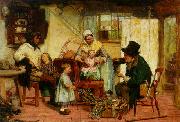 |
David Henry Friston
|
|
(1820 - 1906) was a British illustrator and figure painter in the Victorian Era. He is best remembered as the creator of the first illustrations of Sherlock Holmes in 1887, as well as his illustrations of the controversial female vampire story Carmilla (1872). He is also remembered for his illustrations accompanying reviews of Gilbert and Sullivan operas and plays of W. S. Gilbert in The Illustrated London News and the Illustrated Sporting and Dramatic News in the 1870s and 1880s.
|
|
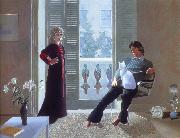 |
david hockney
|
|
Born: 9 July 1937
Birthplace: Bradford, England
Best Known As: British pop artist and critic |
|
 |
David Hunter Strother
|
|
1816-1888
Strother was born in Martinsburg, Virginia (now West Virginia). He studied drawing under Pietro Aneora in Philadelphia, Pennsylvania from 1829 to 1836 when he became a student of Samuel F. B. Morse in New York. Strother was an artist for The Crayon, the leading art journal of the United States at the time, and a frequent contributor to Harper's Monthly. Most of his early work was comprised of landscapes and other outdoor scenes. His art pertained mostly to Virginia and the Southern United States. Prior to the American Civil War, his art was published in books titled The Blackwater Chronicle (1853) and Virginia Illustrated (1857).
During the Civil War, Strother was commissioned by the U.S. Army and assigned as a topographer due to his detailed knowledge of the Shenandoah Valley. During this time, Strother recorded his experiences in the war which he would later publish in Harper's Monthly as "Personal Recollections of the War." His accounts are considered to be unique and are highly praised for their objective viewpoint. He was involved in 30 battles, though never wounded, and was brevetted brigadier general by the War's end.
After the war, topics of his pieces covered a wider range of subjects. Strother began to make works which commented on politics and race relations. He even sketched a portrait of Chief Sitting Bull. Some of his drawings were merely of individuals and groups going about their daily lives.
Strother ended his career as an artist when he was appointed by President Rutherford B. Hayes to be the General Consul to Mexico City in 1879. He returned to West Virginia in 1885 and died there three years later. The New York Times published an obituary in which it is stated that his name was a household one during his career. Strother is buried in Green Hill Cemetery in Martinsburg, West Virginia. |
|
 |
David Octavius Hill
|
|
Scottish Painter and Photographer,
1802-1870
was a founding member of the Royal Scottish Academy and its secretary for 40 years. In 1843 he enlisted the help of Robert Adamson (b. 1821, Berunside, Scot. January 1848, St. Andrews), a chemist experienced in photography, in photographing the delegates to the founding convention of the Free Church of Scotland. They used the calotype process, by which an image was developed from a paper negative. In these and other portraits they demonstrated a masterly sense of form and composition and a dramatic use of light and shade. Their five-year partnership resulted in some 3,000 photographs, including many views of Edinburgh and small fishing villages. |
|
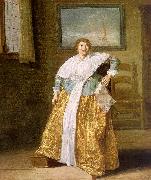 |
Dirck Hals
|
|
Dutch
1591-1656
Dirck Hals Galleries
Dirck Hals (born at Haarlem, 1591-1656) was a Dutch painter of festivals and ballroom scenes. He was influenced by his elder brother Frans Hals. |
|
|
|
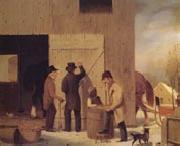 |
Durrie George Henry
|
|
American Painter
b.1820 d.1863
Durrie and his older brother John (1818-98) studied sporadically from 1839 to 1841 with the portrait painter Nathaniel Jocelyn. From 1840 to 1842 he was an itinerant painter in Connecticut and New Jersey, finally settling permanently in New Haven. He produced c. 300 paintings, of which the earliest were portraits (e.g. Self-portrait, 1839; Shelburne, VT, Mus.); by the early 1850s he had begun to paint the rural genre scenes and winter landscapes of New England that are considered his finest achievement. His landscapes, for example A Christmas Party (1852; Tulsa, OK, Gilcrease Inst. Amer. Hist. & A.), are characterized by the use of pale though cheerful colours and by the repeated use of certain motifs: an isolated farmhouse, a road placed diagonally leading the eye into the composition, and a hill (usually the West or East Rocks, New Haven) in the distance. By the late 1850s Durrie's reputation had started to grow, and he was exhibiting at prestigious institutions, such as the National Academy of Design. In 1861 the firm of Currier & Ives helped popularize his work by publishing prints of two of his winter landscapes, New England Winter Scene (1858; Mr and Mrs Peter Frelinghuysen Carleton priv. col.) and the Farmyard in Winter. |
|
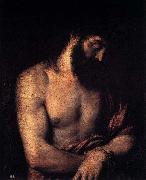 |
Ecce Homo
|
|
are the Latin words used by Pontius Pilate in the Vulgate translation of the John 19:5, when he presents a scourged Jesus Christ, bound and crowned with thorns, to a hostile crowd shortly before his Crucifixion. The King James Version translates the phrase into English as Behold the Man. The scene is widely depicted in Christian art.
The Ecce homo is a standard component of cycles illustrating the Passion and Life of Christ in art. It follows the Flagellation of Christ, the Crowning with thorns and the Mocking of Christ, the last two often being combined. The usual depiction shows Pilate and Christ, the mocking crowd and parts of the city of Jerusalem.
But, from the 15th century, devotional pictures began to portray Jesus alone, in half or full figure with a purple robe, loincloth, crown of thorns and torture wounds, especially on his head. Similar subjects but with the wounds of the crucifixion visible (Nail wounds on the limbs, spear wounds on the sides), are termed a Man of Sorrow(s) (also Misericordia). If the "Instruments of the Passion" are present, it may be called an Arma Christi. If Christ is sitting down (usually supporting himself with his hand on his thigh), it may be referred to it as Christ at rest or Pensive Christ. It is not always possible to distinguish these subjects.
|
|
|
|
|
|
|
|
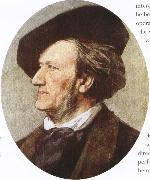 |
eduard hanslick
|
|
German music critic, aesthetician and pioneer of musical appreciation. He studied music with Tom??šek and read law at Prague University, writing his earliest essays for the Prague journal Ost und West and for the Wiener Musikzeitung, the Sonntagsblätter and the Wiener Zeitung. From 1849 to 1861 he was a civil servant, chiefly for the ministry of culture, meanwhile writing for the Presse, publishing his important book Vom Musikalisch-Schönen (1854) and lecturing on music appreciation at Vienna University, becoming full professor in 1870. He was also active as a musical emissary and helped promote the standardization of musical pitch. Among his long-standing friends were Brahms and the philosopher Robert Zimmermann. Though his aesthetic enshrined the classical ideals of orderliness and formal perfection, his interests were limited to the music of his own time. |
|
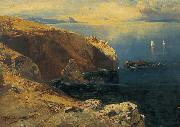 |
Eduard Hildebrandt
|
|
(1818 - October 25, 1868) was a German painter.
He served as apprentice to his father, a house-painter at Danzig. He was not twenty when he came to Berlin, where he was taken in hand by Wilhelm Krause, a painter of sea pieces. Several early pieces exhibited after his deathea breakwater, dated 1838, ships in a breeze off Swinemunde (1840), and other canvases of this and the following yeareshow Hildebrandt to have been a careful student of nature, with inborn talents kept down by the conventionalisms of the formal school to which Krause belonged.
Accident made him acquainted with masterpieces of French art displayed at the Berlin Academy, and these awakened his curiosity and envy. He went to Paris, where, about 1842, he entered the atelier of Isabey and became the companion of Lepoittevin. In a short time he sent home pictures which might have been taken for copies from these artists. Gradually he mastered the mysteries of touch and the secrets of effect in which the French at this period excelled.
He also acquired the necessary skill in painting figures, and returned to Germany, skilled in the rendering of many kinds of landscape forms. His pictures of French street life, done about 1843, while impressed with the stamp of the Paris school, reveal a spirit eager for novelty, quick at grasping, equally quick at rendering, momentary changes of tone and atmosphere.
After 1843 Hildebrandt, under the influence of Humboldt, extended his travels, and in 1864-1865 he went round the world. Whilst his experience became enlarged his powers of concentration broke down. He lost the taste for detail in seeking for scenic breadth, and a fatal facility of hand diminished the value of his works for all those who look for composition and harmony of hue as necessary concomitants of tone and touch.
In oil he gradually produced less, in water colours more, than at first, and his fame must rest on the sketches which he made in the latter form, many of them represented by chromolithography. Fantasies in red, yellow and opal, sunset, sunrise and moonshine, distances of hundreds of miles like those of the Andes and the Himalaya, narrow streets in the bazaars of Cairo or Suez, panoramas as seen from mast-heads, wide cities like Bombay or Pekin, narrow strips of desert with measure-less expanses of skyall alike display his quality of bravura. Hildebrandt died at Berlin on the 25th of October 1868.
|
|
|
|
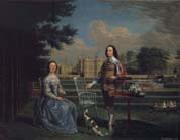 |
Edward Haytley
|
|
British Painter, active 1740-ca.1762,was an English portrait and landscape painter of the 18th century. Little is known about him, but the background of some of his sitters and professional contacts suggest he may have come from Lancashire. Few of his works survive, but he appears to have specialised in the "conversation piece" form popular with the landed gentry of mid-18th century England, a group portrait against an idealised backdrop of the subjects' estates. His works of this form include one of Elizabeth Robinson with her parents, Edward and Elizabeth Montagu, at Sandleford Priory near Hythe, Kent; six portraits of the Stanley family including one of Sir Robert and Lady Bradshaigh in front of Haigh Hall; and two of the Brockman family on its Kent estate, Beachborough, both showing the newly-constructed Temple Pond. One of the latter may include Susanna Highmore, daughter of the portrait painter Joseph Highmore. His best known works are the oil-on-canvas roundels of Bethlem and Chelsea Hospitals donated in 1740, at the behest of William Hogarth, to the Foundling Hospital, London. His last recorded work was a conversation piece of William Milner, second baronet, dated 1764, and he is assumed to have died shortly after this date |
|
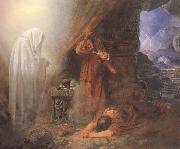 |
Edward Henry Corbould,RI,RWS
|
|
1815-1905
Painter, illustrator and sculptor, son of (2) Henry Corbould. A pupil of Henry Sass (1788-1844) and a student at the Royal Academy, he showed more wide-ranging interests than his father or uncle. He worked in watercolour and briefly in sculpture, winning gold medals for both from the Society of Arts (Fall of Phaeton, watercolour, 1834; St George and the Dragon, sculpture, exh. RA 1835; both untraced). He designed monumental figures for an unexecuted London County Council sculpture project for Blackfriars Bridge (1889), but he concentrated primarily on watercolours of literary and historical subjects, which he exhibited with the New Water-Colour Society from 1837 until 1898. |
|
|
|
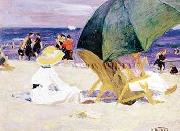 |
Edward Henry Potthast Prints
|
|
American Impressionist Painter, 1857-1927
Edward Henry Potthast (1857 ?C 1927) was an American Impressionist painter.
He was born in Cincinnati, Ohio. From June 10, 1879 to March 9, 1881 he studied with Thomas Satterwhite Noble. He later studied at the Royal Academy in Munich with the American-born instructor Carl Marr. After returning to Cincinnati in 1885 he resumed his studies with Noble. In 1886 he departed for Paris, where he studied with Fernand Cormon. In 1895 he relocated to New York City and remained there until his death in 1927. |
|
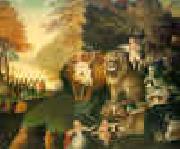 |
Edward Hicks
|
|
1780-1849
Edward Hicks (April 14, 1780 ?C August 23, 1849) was an American Folk painter, a distinguished minister of the Society of Friends, and he also became a Quaker icon because of his paintings.
Edward Hicks was born in his grandfather's mansion at Langhorne, in Bucks County, Pennsylvania. He was born into a life of luxury, and his parents were both Anglican. After his mother passed away when he was eighteen months old, Matron Elizabeth Twining - a close friend of his mother's- raised him as one of her own. She also taught him the Quaker beliefs. This had a great effect on the rest of his life.
At the age of thirteen he was an apprentice for coach makers William and Henry Tomlison. He stayed with them for seven years. His living situation inspired him to desire a much better way of life for himself. He wanted a simple, well respected life and to be able to earn his own wages. He wanted to be able to make choices for himself, in all that he did. It was then that he knew that something amusing and entertaining such as a career in art could satisfy his goals. He spent three years contemplating what his life meant to him, and grew a strong passion for art. His religious commitments affected his thoughts on living and art in many ways. In 1803, he married a Quaker woman named Sarah Worstall. |
|
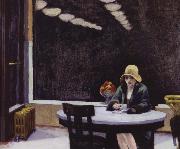 |
edward hopper
|
|
American painter, printmaker and illustrator. He was brought up in a town on the Hudson River, where he developed an enduring love of nautical life. When he graduated from Nyack Union High School in 1899, his parents, although supportive of his artistic aspirations, implored him to study commercial illustration rather than pursue an economically uncertain career in fine art. He studied with the Correspondence School of Illustrating in New York City (1899-1900). He continued to study illustration at the New York School of Art (1900-1906), under Arthur Keller (1866-1925) and Frank Vincent Du Mond (1865-1951), but began to study painting and drawing after a year. Hopper began in the portrait and still-life classes of William Merrit Chase, to whose teaching he later referred only infrequently and disparagingly. He preferred the classes he took with Kenneth Hayes Miller and especially those of Robert Henri. Hopper s skill won his fellow students respect, as well as honours in the school where, by 1905, he was teaching Saturday classes.
|
|
 |
Edward lamson Henry
|
|
A popular and prolific genre artists at the end of the 19th century
American , 181-1919
American painter. He received his first art instruction in New York from Walter M. Oddie (1808-65), followed by two years at the Pennsylvania Academy of the Fine Arts, Philadelphia (1858-60). After this he left for a two-year stay abroad, studying with Paul Weber (1823-1916), Charles Gleyre and Courbet. In 1864 he served as a captain's clerk on a boat taking supplies to the Union army. Two notable pictures that emerged from this experience were City Point, Virginia, Headquarters of General Grant (1865-72; Andover, MA, Phillips Acad., Addison Gal. A.) and Westover Mansion (1869; Washington, DC, Corcoran Gal. A.). He soon won recognition and was elected to the National Academy by 1869. Many of his paintings were sold before exhibition, |
|
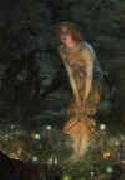 |
Edward Robert Hughes
|
|
British
1851-1917
Edward Robert Hughes (1851-1917) is a well known English painter who worked in a style influenced by Pre-Raphaelitism and Aestheticism. Some of his best known works are Midsummer Eve and Night With Her Train of Stars. Hughes was the nephew of Arthur Hughes. He often used watercolour/gouache. He was elected ARWS in 1891 and chose as his diploma work for election to full membership a mystical piece inspired by a verse by Christina Rossetti's "Amor Mundi". Technically Hughes experimented with ambitious techniques. He was a perfectionist who did numerous studies which in their own right turned out to be good enough for exhibition
He was also an assistant to the elderly William Holman Hunt. He helped the increasingly infirm Hunt with the version of The Light of the World now in St. Paul's Cathedral and with The Lady of Shalott. He died on April 23 1914 at his cottage in St. Albans, Hertfordshire.
|
|
|
|
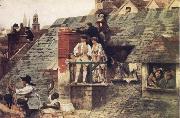 |
Edwin Howland Blashfield
|
|
mural painter and mosaic designer.
American ,1848-1936
American painter. He began to study art seriously in 1867 in Paris under L?on Bonnat, with whom he remained (except between 1870 and 1874) until 1880. Blashfield's mural style was significantly influenced by Pierre Puvis de Chavannes, Jean-Paul Laurens and Paul Baudry, whose decorations he had studied in the Panth?on while in Paris. He made a trip in 1887 to England, where he became briefly associated with the Anglo-American artists' colony in Broadway, Glos, which included Edwin Austin Abbey, John Singer Sargent, Lawrence Alma-Tadema and Frederic Leighton. |
|
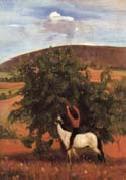 |
Egedius, Halfdan
|
|
1877-1899,Norwegian painter and illustrator. His artistic education began at the age of nine, when he enrolled at the school of art of Knud Bergslien (1827-1908) in Kristiania, where he was a pupil from 1886 to 1889. Even from this early period his painted studies and drawings, for instance of his sister Signe and brother Carl (both 1887; Oslo, N.G.), reveal striking maturity. In 1891 he was a pupil of Erik Werenskiold and from 1891 to 1892 he studied at the Arts and Crafts School in Kristiania. Egedius discovered his strongest impetus and greatest inspiration, however, on his first visit to Telemark in south-west Norway in summer 1892. The artist Torleif Stadskleiv (1865-1946), whom he met there and who became his closest friend, endeared the region to Egedius with stories of its traditions and people. In 1894 Egedius studied for a short period under Harriet Backer, and he made his d?but at the Kristiania Autumn Exhibition in 1894 with the painting Saturday Evening (Oslo, N.G.), painted in Telemark the previous year, which won high praise. In this landscape the atmosphere of the summer night is rendered with a lyrical use of colour and soft brushstrokes. Egedius spent the summer of 1894 in the inspiring and instructive company of a group of artists at V?g? in the Gudbrands Valley in north-west Norway, but for the summer of 1895 he was again in Telemark. Since his previous stay there he had matured artistically and his work now revealed a new confidence and boldness. The most notable paintings from 1895 are 'Juvrestolen' in Telemark, The Dreamer, Girls Dancing and the magnificent portrait of Mari Clasen (all Oslo, N.G.). He also began work on Music and Dance (Oslo, N.G., see fig.), which he continued the following year. |
|
|
|
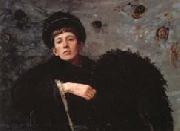 |
Ellen Day Hale
|
|
1855-1940
was an American painter and printmaker. She was born in Worcester, Massachusetts, her family was involved in the arts, her father Edward Everett Hale was an author, her great-aunt Harriet Beecher Stowe wrote Uncle Tom's Cabin. She studied art under Boston painter William Morris Hunt and helped raise her 7 brothers and sisters. Later she studied in at the Academie Julien in Paris. |
|
|
|
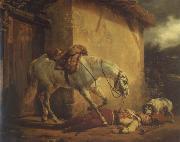 |
Emile Jean Horace Vernet
|
|
French, 1789-1863,Painter, son of Carle Vernet. He was born in his father's lodgings at the Palais du Louvre, where his grandfather Joseph Vernet also lived; his maternal grandfather was Jean-Michel Moreau. To these antecedents and influences are ascribed the supreme ease of his public career, his almost incredible facility and his fecundity. His early training in his father's studio was supplemented by formal academic training with Francois-Andre Vincent until 1810, when he competed unsuccessfully for the Prix de Rome. He first exhibited at the Salon in 1812. In 1814 Vernet received the Legion d'honneur for the part he played in the defence of Paris, which he commemorated in the Clichy Gate: The Defence of Paris, 30 March 1814. |
|
|
|
|
|
|
|
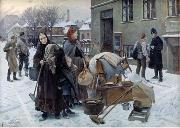 |
Erik Henningsen
|
|
(29 August 1855 - 28 November 1930) was a Danish painter and illustrator. He is best known for his Social Realist paintings of poor and exposed groups in the 1880s and 1890s. He was the younger brother of Frants Henningsen who was also a painter.
Erik Henningsen was born on 29 August 1855 in Copenhagen to Frants Ludvig Henningsen (1820-1869), a grocer, and Hilda Charlotte Christine ne Schou (1824-1880). He showed an early artistic talent and was articled to decorative painter A. Hellesen. He also took drawing lessons privately with C. V. Nielsen and was admitted to the Royal Danish Academy of Fine Arts in 1873. He graduated in 1877 and won several awards and distinctions, including the Academy's Annual Medal in 1887 and 1890, the Ancher Prize in 1889. |
|
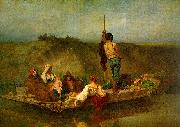 |
Ernest Hebert
|
|
1817-1908
French
Ernest Hebert Gallery
He was born in Grenoble and died in La Tronche. His painting Mal aria was exhibited in the Salon of 1850-1851, and now hangs in the Musee d Orsay, Paris. Painted in a Romantic style, it depicts a family of Italian peasants escaping an epidemic by raft, a scene inspired by events Hebert had witnessed while in Italy.
His student Paul Trouillebert was an important artist of the Barbizon School.
The artist house is preserved in the Musee Hebert in the VIe arrondissement of Paris. There is another museum near Grenoble. |
|
|
|
|
|
|
|
|
|
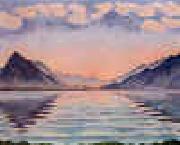 |
Ferdinand Hodler
|
|
1853-1918
Swiss Ferdinand Hodler Galleries
Hodler was born in Berne and grew up in poverty. His father, Jean Hodler, made a meager living as a carpenter; his mother, Marguerite (n??e Neukomm), was from a peasant family. By the time Hodler was eight years old, he had lost his father and two younger brothers to tuberculosis. His mother remarried to a decorative painter, but in 1867 she too died of tuberculosis. Before he was ten, Hodler received training in decorative painting from his stepfather, and was subsequently sent to Thun to apprentice with a local painter, Ferdinand Sommer. Hodler's earliest works were conventional landscapes, which he sold in shops and to tourists. In 1871, at the age of 18, he traveled on foot to Geneva to start a career as a painter.
The works of Hodler's early maturity consisted of landscapes, figure compositions and portraits, treated with a vigorous realism. He made a trip to Basel in 1875, where he studied the paintings of Hans Holbein??especially Dead Christ in the Tomb, which influenced Hodler's many treatments of the theme of death. In the last decade of the 19th century his work evolved to combine influences from several genres including symbolism and art nouveau. He developed a style which he called Parallelism, characterized by groupings of figures symmetrically arranged in poses suggesting ritual or dance.
In 1884 Hodler met Augustine Dupin (1852?C1909), who became his companion and model for the next several years. Their son, Hector Hodler, was born in 1887. In 1889 Hodler married Bertha Stucki; they were divorced in 1891.
Hodler's work in his final phase took on an expressionist aspect with strongly coloured and geometrical figures. Landscapes were pared down to essentials, sometimes consisting of a jagged wedge of land between water and sky. However, the most famous of Hodler's paintings portray scenes in which characters are engaged in everyday activities, such as the famous woodcutter (Der Holzfaller, Mus??e d'Orsay, Paris). This picture went on to appear on the back of the 50 Swiss Franc bank note issued by the Swiss National Bank.
In 1898, Hodler married Berthe Jacques. In 1914 he condemned the German atrocities conducted using artillery at Rheims. In retaliation for this, German art museums excluded Hodler's work.
In 1908 he met Valentine Gode-Darel, who became his mistress. She was diagnosed with cancer in 1913, and the many hours Hodler spent by her bedside resulted in a remarkable series of paintings documenting her disintegration. Her death in January 1915 affected Hodler greatly. He occupied himself with work; a series of about 20 introspective self-portraits date from 1916. By late 1917 his declining health led him to thoughts of suicide. He died on May 19, 1918 in Geneva leaving behind a number of unfinished works portraying the city. |
|
|
|
|
|
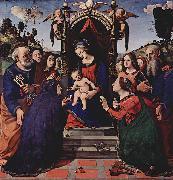 |
Fitz Henry Lane
|
|
(December 19, 1804 - August 14, 1865) was an American painter and printmaker of a style that would later be called Luminism, for its use of pervasive light.
Fitz Henry Lane was born on December 19, 1804, in Gloucester, Massachusetts. Lane was christened Nathaniel Rogers Lane on March 17, 1805, and would remain known as such until he was 27. It was not until March 13, 1832 that the state of Massachusetts would officially grant Lanees own formal request (made in a letter dated December 26, 1831) to change his name from Nathaniel Rogers to Fitz Henry Lane. As with practically all aspects of Lanees life, the subject of his name is one surrounded by much confusioneit was not until 2005 that historians discovered that they had been wrongly referring to the artist as Fitz Hugh, as opposed to his chosen Fitz Henry, and the reasons behind Lanees decision to change his name, and for choosing the name he did, are still very unclear.
|
|
|
|
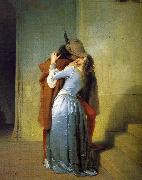 |
Francesco Hayez
|
|
1791-1882
Italian
Francesco Hayez Galleries
Hayez came from a relatively poor family from Venice. His father was of French origin while his mother, Chiara Torcella, was from Murano. The child Francesco, youngest of five sons, was brought up by his mother sister, who had married Giovanni Binasco, a well-off shipowner and collector of art. From childhood he showed a predisposition for drawing, so his uncle apprenticed him to an art restorer. Later he became a student of the painter Francisco Magiotto with whom he continued his studies for three years. He was admitted to the painting course of the New Academy of Fine Arts in 1806, where he studied under Teodoro Matteini. In 1809 he won a competition from the Academy of Venice for one year of study at the Accademia di San Luca in Rome. He remained in Rome until 1814, then moved to Naples where he was commissioned by Joachim Murat to paint a major work depicting Ulysses at the court of Alcinous. In the mid 1830s he attended the Salotto Maffei salon in Milan, hosted by Clara Maffei (whose portrait Hayez painted for her husband), and he was still in Milan in 1850 when he was appointed director of the Academy of Brera there.
Assessment of the career of Hayez is complicated by the fact that he often did not sign or date his works. Often the date indicated from the evidence is that at which the work was acquired or sold, not of its creation. Moreover he often painted the same compositions several times with minimal variations, or even with no variation. His early works show the influence of Ingres and the Nazarene movement. His later work participates in the Classical revival. |
|
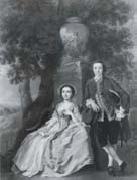 |
Francis Hayman
|
|
English Painter, 1708-1776,English painter and illustrator. He was in London at the age of 10, and from 1718 until c. 1725 he was apprenticed to Robert Brown (d 1753), a decorative painter. From 1732 Hayman was employed as a scene painter at Goodman's Fields Theatre, where he painted allegorical works such as The King Attended by Peace, with Liberty and Justice Trampling on Tyranny and Oppression on the pit ceiling (destr.). He moved to Drury Lane Theatre in 1736, shortly before the Licensing Act closed Goodman's Fields. At Drury Lane he painted scenery for Thomas Arne's masque The Fall of Phaeton (1736) and was praised for his naturalistic landscapes. From the late 1730s he began accepting commissions for portraits and conversation pieces. His success in the field of portraiture rested on the dearth of good portrait painters in England at the time and his exploitation of a growing middle-class clientele. Hayman painted portraits of doctors, literary men and actors. |
|
 |
Francis Holman
|
|
(1729-1784) was a British maritime painter, little recognised during his own lifetime, but whose paintings are now sought aftereHe is also notable as the teacher of Thomas Luny.
He was born in Ramsgate and baptized on 14 November 1729 at St Laurence-in-Thanet, Ramsgate.[1] He was the eldest son and second of six children of Francis Holman (1696-1739), and his wife, Anne Long (1707-1757). His father was a master mariner, and his grandfather a Ramsgate cooper. His younger brother, Captain John Holman (1733-1816), maintained the family shipping business and remained close to Francis throughout his life. Young Francis would certainly have been immersed in the maritime world during his up-bringing; the legacy of this early knowledge is a wealth of detail and accuracy in his later work.
The moonlight Battle of Cape St Vincent, 16 January 1780 by Francis Holman, painted 1780
A sixth-rate British man of war off Dover, by Francis Holman, 1777
A small shipyard on the Thames, by Francis Holman, between 1760 and 1784Francis Holman lived in at least five addresses in Wapping on the Thames in London. He married, firstly, Elizabeth, and they produced 3 sons; John (b. 1757), and two more sons, both named Francis, who died in infancy. Elizabeth's death is unrecorded, but on 7 May 1781 he married, secondly, Jane Maxted (c.1736-1790). He was apparently childless when he wrote his will in 1783.
|
|
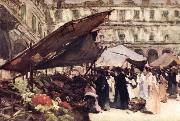 |
Francis Hopkinson Smith
|
|
Engineer, artist, illustrator, and short story writer
American , 1838-1915
United States author, artist and engineer, was born in Baltimore, Maryland, a descendant of Francis Hopkinson, one of the signers of the Declaration of Independence. Smith became a contractor in New York City and did much work for the federal government, including the stone ice-breaker at Bridgeport, Connecticut, the jetties at the mouth of the Connecticut River, the foundation for the Bartholdi Statue of Liberty in New York Harbor, the Race Rock Lighthouse (southwest of Fishers Island, New York) and many life-saving stations. His vacations were spent sketching in the White Mountains, in Cuba and in Mexico. |
|
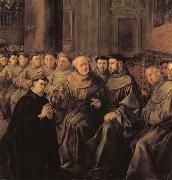 |
Francisco de herrera the elder
|
|
Spanish Baroque Era Painter, ca.1590-1656
Spanish painter. His early works are in the Mannerist style. Under the influence of Francisco Zurbaren, he developed the naturalistic style seen in his four scenes from the life of St. Bonaventure (1627). About 1650 he moved to Madrid. His last documented work, a painting of St. Joseph (1648) influenced by Anthony Van Dyck, features elongated forms and elaborate draperies. He achieved considerable fame in Sevilla, where Diego Velezquez was briefly his pupil. His work marked the transition from Mannerism to the Baroque. His son, Francisco Herrera the Younger |
|
|
|
|

